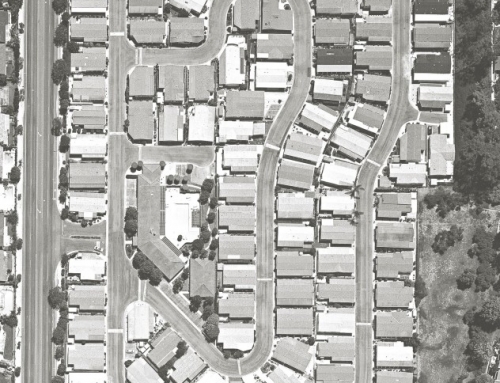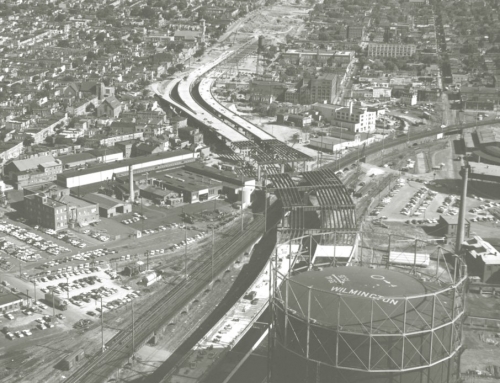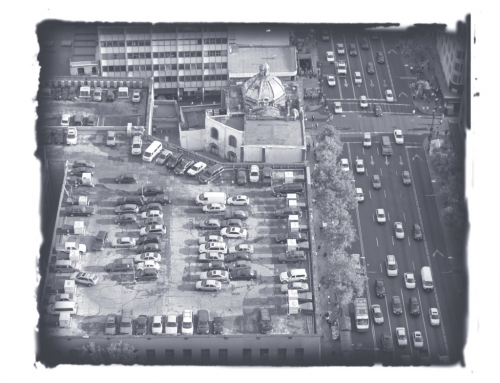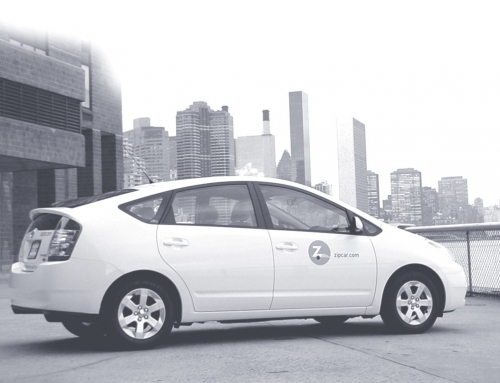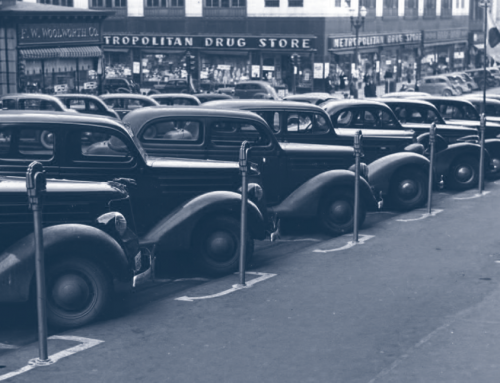Thirty-five years ago, economist John Kain proposed several simple pricing mechanisms for roadways that would “improve urban transportation at practically no cost.” At about the same time, Nobel laureate William Vickrey championed a number of likeminded ideas, especially in New York City, that would reduce traffic congestion and improve the efficiency of the transport sector. Some of these proposals would also involve “practically no cost,” even using the technology of the 1960s. For example, Vickrey proposed varying the tolls on New York’s George Washington Bridge with the time of day, which would make rush-hour driving more expensive and reduce traffic congestion.
At first, only Singapore implemented this simple idea. In June 1975, in an attempt to reduce downtown congestion, Singapore introduced the world’s first comprehensive road pricing program. The Area Licensing Scheme, as it was called, imposed a toll on vehicles entering a restricted zone near Singapore’s central business district during business hours on workdays. Some fifteen years after the Singapore demonstration, the three largest cities in Norway—Bergen, Oslo, and Trondheim—introduced urban toll systems on circumferential roads. However, the rationale for these latter innovations was not to reduce congestion but rather to generate revenues for urban transport investments. In 2003, the City of London adopted a version of Singapore’s Area Licensing Scheme specifically to help control downtown congestion.
The examples set by London, Singapore, and the Norwegian cities have stimulated discussions of congestion pricing among traffic engineers, planners, politicians, and administrators in many US and European cities. But elected officials in many cities have rejected proposals for road pricing for fear that they are politically infeasible. These fears seem to be justified by survey results from both Europe and the US. Well-known studies of citizen preferences observe that public and political acceptability is an important precondition for the successful implementation of road pricing, and that the political acceptability of road pricing is rather low.
The only city where congestion pricing has been adopted freely by a vote of the electorate is Stockholm.
The only city where congestion pricing has been adopted freely by a vote of the electorate is Stockholm. Shortly after the 2002 national elections in Sweden, the new national government resolved to sponsor a full-scale experiment with a system of congestion charges for the city of Stockholm. A pricing scheme for roadways would be combined with a short-term increase in the capacity of the public transportation system. The Parliament also decided that a referendum on the permanent implementation of the system of charges should be held in Stockholm after the trial period was over, in conjunction with the general election of September 2006. After a trial of almost seven months, the charging system was approved by a majority (52 percent) of the city’s voters. The pricing scheme was re-introduced in August 2007, and has been in force continuously ever since. Stockholm thus represents the first time a congestion toll was imposed by a plebiscite.
Since it has been widely asserted that congestion tolls are politically unpopular, observing a popular vote on such tolls provides an opportunity to analyze the factors that influence public acceptance of priced roadways. The Stockholm case also provides an opportunity to observe how citizen voters make tradeoffs between the time and money costs of travel, and how these costs influence the willingness to impose a system of congestion tolls.

The Congestion Charge
The system of congestion charges imposed in Stockholm during the first half of 2006 was quite simple. A cordon surrounding the inner city was established and 18 gantries monitored traffic flowing across the perimeter. Vehicles crossing the perimeter were assessed the congestion toll. Vehicles were identified either by transponders or by cameras that photographed license plates as they crossed the cordon. About 95 percent of charges were identified automatically, and bills were sent automatically to pre-registered users. Figure 1 shows the inner parts of Stockholm and the perimeter of the toll zone, as well as the locations of the monitoring devices.
The charging system was also simple: 10 Swedish Crowns (SEK) were charged for off-peak travel across the cordon boundary in both directions, and up to 20 SEK were charged for peak-hour travel, with a maximum charge of 60 SEK to any user in a day (10 SEK is about $1.50). Charges were not imposed in the evenings, on weekends, or on public holidays, and some vehicles were exempt from charges altogether (for example, taxis and emergency vehicles). Simplicity and ease of understanding were the main reasons for this choice of design.
The Politics
Activists and elected leaders had discussed congestion charging in Stockholm since the 1980s. Throughout, the discussion was characterized by strong differences among political parties as well as among politicians at both the national and local levels. The debate was also influenced by shifting political majorities and alliances, again both nationally and locally. The 2002 congestion pricing initiative came about as a result of some of these shifting alliances, which resulted from the 2002 national elections. The Social Democrats had won a large plurality and formed a government, in part by attracting the support of the Environmentalist Party. In exchange for this support, the Social Democrats agreed to an experiment in congestion charging. Together, the Environmentalists and the national Social Democrats convinced the Stockholm Social Democrats (who had promised not to impose congestion pricing should they gain control of the city) to implement the experiment. On the other end of the political spectrum, after the 2002 election the opposition parties—the Christian Democrats, the Conservatives, the Liberals, and the Centre Party—formally decided to cooperate with one another. They proclaimed themselves the “Alliance,” and during the run-up to the 2006 election presented a common platform on all major political issues, including opposition to the congestion charges.
The 2002 congestion pricing initiative came about as a result of some of these shifting alliances, which resulted from the 2002 national elections.
The congestion pricing program put the Stockholm Social Democrats in a vulnerable position. Opinion polls taken before the election showed that the share of the adult population in the Stockholm Region supporting the congestion charge experiment had fallen significantly between 2004 and 2005. Ultimately, the confidence of the Social Democrats increased when the results from the last opinion poll undertaken during the trial were released; the share supporting the experiment increased to 54 percent.
The increased public support reported during the experiment turned out to be a good predictor of the referendum outcome: 52 percent of the electorate supported the charge. The victory for the congestion tolls did not, however, lead to more votes for the political parties advocating pricing. On the contrary, the general election in 2006 resulted in a clear victory for the parties opposing a system of tolls. The Alliance polled 54 percent of the vote, up from 48 percent in 2002.
| Figure 1
Perimeter of Congestion Zone and Location of the 18 Gantries |
Effects of the Charging System and Their Influence on the Referendum
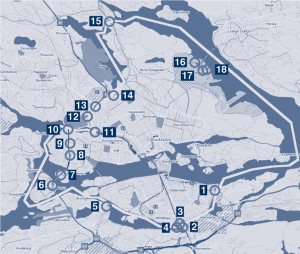
Well before the referendum was held in the fall of 2006, the city of Stockholm published a detailed compendium of the results of the congestion pricing trial. A key finding was that the number of vehicles crossing the charge cordon declined by about 22 percent. Underlying the broad discussion in the compendium were the results of a sophisticated, but standard, traffic engineering model that simulated the effects of the tolling system on neighborhoods and traffic zones.
Although the congestion charge passed by a vote of 52 to 48 percent, in 26 voting districts fewer than 40 percent of voters supported the tolls, and in another 42 districts over 60 percent did. We can relate this variability in citizen preferences to the time savings and incremental transportation costs experienced by voters in the various districts. Using standard GIS methods, we allocated the voting and demographic data to the roughly 339 zones defined in the traffic engineering model. The data reveal substantial variability in demographic characteristics and political ideology by zone, and also in the distribution of time savings and incremental travel costs attributable to the system of congestion tolls.
Ideology and Self Interest
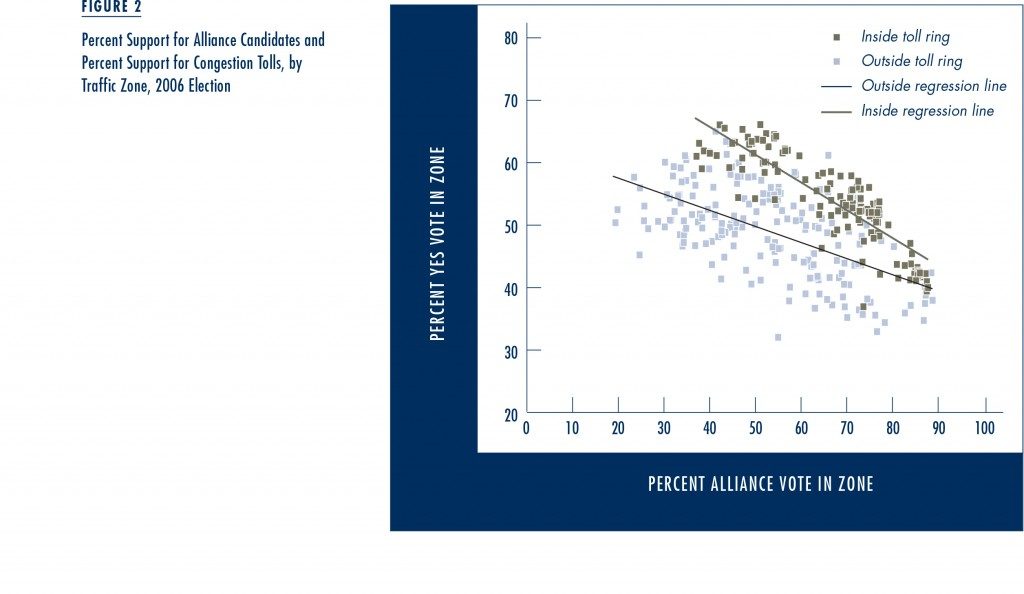 Figure 2 shows the relationship between the percentage of voters in each district in favor of the system of tolls in the 2006 election and the percentage of voters in the district who supported one of the parties in the Alliance (which opposed the system of tolls) in the same election. An inverse relationship is clear. Voters who were more likely to favor Alliance candidates were also more likely to oppose the tolls. It is also clear that voters who resided inside the cordon were more likely to favor the toll system. Not only did these residents, on average, face lower costs (that is, no toll charges) if they commuted to the central core, but their homes and neighborhoods also benefited from the reduced traffic within the cordon.
Figure 2 shows the relationship between the percentage of voters in each district in favor of the system of tolls in the 2006 election and the percentage of voters in the district who supported one of the parties in the Alliance (which opposed the system of tolls) in the same election. An inverse relationship is clear. Voters who were more likely to favor Alliance candidates were also more likely to oppose the tolls. It is also clear that voters who resided inside the cordon were more likely to favor the toll system. Not only did these residents, on average, face lower costs (that is, no toll charges) if they commuted to the central core, but their homes and neighborhoods also benefited from the reduced traffic within the cordon.
Using statistical analysis, we dug deeper into the election results to see why people in some zones were more likely to support the congestion charge. We were particularly interested in testing two ideas. The first was that people would vote their narrow self-interest. That is, we assumed that those who gained the most (because their travel times fell) or perhaps lost the least (because they rode public transit and therefore wouldn’t pay the toll) would support the congestion charge. Those who paid the most in tolls, by contrast, would oppose the tolls. The second idea was that people would demonstrate political loyalty. The Alliance came out strongly against the congestion charge, so we suspected that people living in areas with many Alliance voters would oppose the tolls.
We found strong statistical evidence to support both hypotheses. To be sure, a number of factors influenced support for or opposition to congestion tolls: better educated voters and working-age voters tended to favor the tolls, while male workers and immigrants tended to oppose them. But time and money savings were influential, even after controlling for these demographic attributes. Voters in traffic zones where the average time savings were higher were more likely to support the congestion charge. In contrast, voters in zones where the average cost of a trip rose the most were less likely to support congestion charging. And voters who lived in zones within the tolling area were more likely to favor the congestion tolls. The most likely explanation for this latter finding is, again, that the congestion charge brought about other changes—reduced traffic, pollution and noise—that made these neighborhoods nicer places to live.
The transit share of a zone’s commuters appears to explain none of the variation in voting outcomes.
Somewhat to our surprise, holding time and money costs constant, we found no evidence that voters in zones with more public transportation users were more likely to vote for the congestion charge. In fact, the transit share of a zone’s commuters appears to explain none of the variation in voting outcomes. Thus the voting outcome did not simply reflect a tendency of transit users to favor tolls while auto users opposed them. Rather, the vote reflected a more subtle relationship between the time savings and the cost increases associated with the tolling system. For some voters, the time savings from the tolls outweighed the monetary costs; these voters were more likely to support congestion charging. For others, the opposite was true; these voters were much more likely to oppose the tolls.
Alliance voters were much more likely than others to vote against the congestion charge, suggesting that political ideology did play a large role in the fate of the congestion charge at the ballot box. However, it is difficult to isolate the causal direction of this relationship. While it is likely that many Alliance voters cast their ballots against the congestion charge because of their partisan allegiance, it is also possible that some voters supported the Alliance because it was opposed to congestion charging. In other words, it’s hard to say with certainty whether stronger support for the Alliance led to opposition to congestion charging, or whether opposition to congestion charging led to stronger support for the Alliance. Nevertheless, the association between political party and voting on congestion charging was powerful.
Conclusions
In sum, the analysis suggests that voters’ more general political preferences influenced their vote on the congestion charge. The results also clearly document the importance of the private costs and benefits—the time savings in commuting and the tariffs paid by motorists arising from the tolls—in conditioning the acceptance of the system and in affecting voting behavior.
The empirical results suggest that a 10 percent decrease in commute time could increase the propensity to favor the tolling system by an average of 2 percentage points. A 10 percent increase in the incremental costs of commuting, by contrast, is associated with a decline of 4 percent in the approval rate of congestion tolls. The tradeoff between time savings and out-of-pocket costs in the voting calculus also says something about how much people value their commuting time. Our statistical results suggest that one hour of travel time saving is valued at between 53 and 69 SEK; this is roughly the same as the value of time for private trips used in benefit-cost calculations by the Swedish National Road Administration.
The tradeoff between time savings and out-of-pocket costs in the voting calculus also says something about how much people value their commuting time.
One implication of these findings is that consumers who experience the benefits of tolling firsthand may be more willing to support congestion charges. This suggests that there is considerable scope for well-designed experiments that tangibly demonstrate the effects of congestion tolls on the welfare of urban commuters. These well-thought-out experiments may lead to more efficient transportation policies.
Further Readings
Richard Arnott and Kenneth Small. 1994. “The Economics of Traffic Congestion,” American Scientist, 82: 446–455.
Bjorn Hårsman and John Quigley. 2010. “Political and Public Acceptability of Congestion Pricing,” Journal of Policy Analysis and Management, 29 (4): 854–874.
John Kain. 1972. “How to Improve Transportation at Practically No Cost,” Public Policy, 20: 335–352.
Jonathan Leape. 2006. “The London Congestion Charge,” Journal of Economic Perspectives, 20 (4): 157–176.
Sock-Yong Phang and Rex Toh. 2004. “Road Congestion Pricing in Singapore: 1975 to 2003,” Transportation Journal, 43 (2): 16–25.
Jens Schade and Bernhard Schlag (Eds.). 2003. Acceptability of Transport Pricing Strategies, Oxford: Elsevier Science.
William Vickrey. 1963. “Pricing in Urban and Suburban Transport,” American Economic Review, 52 (2): 452–465.
[/fusion_text]


